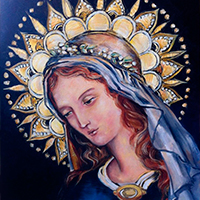Bl. Vincent Lewoniuk and his twelve companions
Source: Catholicsaints.info

Roman martyrology: At Pratulin in Poland, Blessed Vincent Lewoniuk and twelve companions, martyrs, who for not having given in to the threats and blandishments of those who wanted them away from the Catholic Church and for refusing to hand over the keys their parish, were mortally wounded and killed. (1874).
Beatification date: October 6, 1996 by Pope John Paul II.
SHORT BIOGRAPHY
Today we commemorate the Martyrs of Pratulin, as Blessed Vincent Lewoniuk and Companions (For those in Albuquerque: there is a large icon of this event on the south wall of Our Lady of Perpetual Help Church, where the different martyrs’ icons hang).
After 1839, the Russian Empire contained one last Byzantine Catholic eparchy, Chelm/ Kholm. All of the others had been shut down in 1839 after some priests and monks of the Greek Catholic Church had supported the Poles in their risings against the Russian Empire. Kholm had survived, as it technically was a territory under Russian occupation, but not annexed to Russia. There had been a lot of liturgical latinization: installing side altars, adding Latin Rite-styled devotions, even pulling down icon-screens and bringing in organs in some places. There was also some polonization of the faithful: in many places Polish was used for sermons, not Ukrainian or local dialects; Polish hymns were sung; Polish bibles used in the churches.
Tsar Nicholas I decided to destroy this last stronghold of 246,000 faithful and convert it to the Russian Orthodox Church. Bishops were appointed who were told to de-Latinize the parishes. But instead of following examples across the border in the Austrian Empire, Russian Orthodox practices were introduced. This was to prepare the way for a full suppression. Nicholas expelled a very good bishop to Austria, and appointed a bishop who would follow his directives, Markyl Popel. Under the guise of de-latinizing (and some things he eliminated did not belong in a Greek Catholic church, like organs), he went further and forbade prayers for the Pope, ordered liturgical books from Moscow for the churches, and ordered prayers for the Russian Holy Synod. The faithful, mostly peasants, saw this -correctly – as a drive to convert them to the Russian Orthodox Church. In 1873, this traitorous bishop declared that as of January 1, 1874, all priests must break with Rome and that the Union would be abolished. Those who refused would be sent to Siberia or put into a prison. This is important to understand what happened at Drelow, another parish: at the end of the Pratulin account. Some parishioners gave up the struggle; others joined the Latin rite parishes if they were available; but a large population later called the “Stubborn Ones” decided to hold out.
Finally, in 1874, Orthodox priests were introduced into the parishes, accompanied by soldiers from the army. In several places where there was resistance, the soldiers engaged in massacre, rape, and looting. The best documented of these was Pratulin.
Vincent Lewoniuk and twelve other men, ages 12 – 50, gathered at the front door of their church on January 24, 1874, to prevent a Russian Orthodox priest coming in to introduce Orthodox faith and rituals in their parish. Vincent opened his shirt to reveal his baptismal cross on his chest. “You can kill me, but you cannot kill the Church.” At that, the soldiers opened fire, killing these thirteen and wounding others. The crucifix, which they held was saved by survivors and today hangs in the museum at the site. The bodies of the martyrs were dumped into a common grave, but the Faith they defended held on.
They are exemplars of the apostolate of the laity: defending the Faith unto death. The survivors also show the apostolate of the laity, as the Stubborn Ones maintained secret priests brought in from the Austrian Empire, organized lay-led prayer services, and taught the Byzantine Catholic Faith to the communities.
In 1905, Tsar Nicholas II allowed the Stubborn Ones to become officially Catholic again, but only by joining Latin rite parishes only: 100,000 did so. In 1990, the Byzantine Catholic descendants of this eparchy emerged in Belarusand northern Ukraine with an estimated membership of 80 – 100,000. Today the Greek Catholic Church struggles in Belarus, waiting for a bishop to be appointed, but that is another story. These martyrs were declared blessed by Pope John Paul II.














